Finding the Right Wattage for Bathroom Lighting
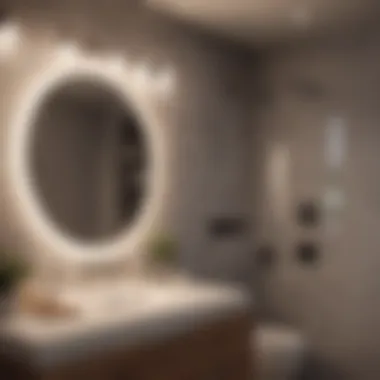
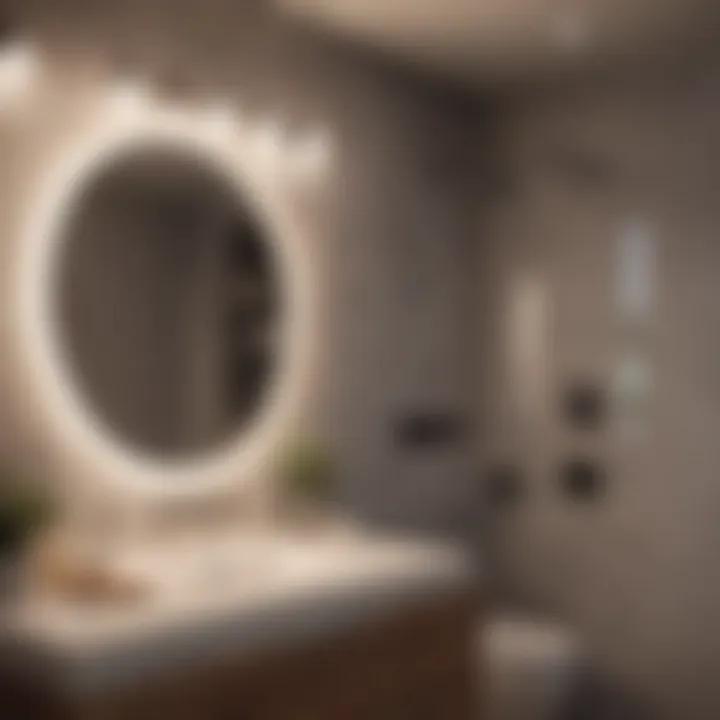
Intro
Choosing the right wattage for bathroom lighting is a crucial aspect of any home design. Proper illumination can transform a dull, ordinary space into one that feels welcoming and functional. Understanding what influences wattage selection is key to achieving the right atmosphere in this intimate area of the home.
When thinking about wattage, various factors must be taken into account. This includes the bathroom's size, the types of fixtures selected, and the kind of ambiance desired. A well-lit bathroom serves numerous purposes, from ensuring safety to improving the overall aesthetic appeal. Additionally, homeowners should consider energy efficiency, minimizing costs without sacrificing illumination quality.
This article delves into these aspects to equip readers with the knowledge required to make informed lighting decisions. By the end, you should have a clearer perspective on how to enhance both functionality and ambiance in your bathroom through appropriate wattage choices.
Design Inspirations
Trending Styles
Bathroom lighting has evolved with changing design trends. Current styles reflect a mix of modernity and functionality. Many homeowners are opting for pendant lights over vanities, creating a focal point while providing essential brightness. Recessed lighting has also gained popularity, offering a sleek and understated illumination option.
On the other hand, vintage fixtures can add character. Wall sconces with a classic design can illuminate the room effectively while enhancing its charm. Choosing fixtures that align with the overall bathroom design plays a crucial role in the outcome of the space.
Color Palettes
The color of your bathroom can significantly influence lighting needs. Light colors reflect more light than dark hues, which absorb it. For example, a bathroom painted in soft whites or pastels may require less wattage compared to darker shades which tend to require brighter lighting. Natural light sources, such as windows, should also be factored into this calculation since they can affect how much additional lighting is needed.
When selecting color palettes, consider how the lighting will interact with the surrounding colors. Complimentary tones can create a balanced and harmonious look.
"Optimal wattage not only illuminates but also enhances the aesthetic of the bathroom." – Lighting Expert
Maintenance and Upkeep
Seasonal Maintenance Checklist
Regular maintenance of bathroom lighting is essential for longevity and performance. Here are some recommended steps:
- Inspect Fixtures: Check for any damage such as loose wires or burnt-out bulbs.
- Clean Regularly: Dust and grime can accumulate, which may diminish brightness. Use a soft cloth for delicate fixtures.
- Replace Bulbs: Consider energy-efficient options like LED lights, which require less frequent replacement.
Cleaning and Organization Tips
Maintaining a clean lighting space improves functionality. Ensure that pathways to fixtures are free from obstructions. Also, organize storage spaces near light sources to eliminate clutter that might affect lighting perception.
In summary, making informed choices regarding wattage can significantly enhance the bathroom experience. Understanding design aspects, regular maintenance, and the color influence maximizes functionality while ensuring aesthetic appeal.
Understanding Bathroom Lighting Needs
Proper lighting in a bathroom does more than just illuminate the space. It plays a crucial role in both functionality and aesthetic appeal. Understanding bathroom lighting needs is the first step in creating a space that is not only usable but also comfortable and inviting. The right wattage ensures that tasks can be completed efficiently without straining the eyes, while also enhancing the overall atmosphere of the room.
Importance of Adequate Lighting
Adequate lighting is essential in a bathroom for various reasons. First, it directly affects the safety and convenience of tasks like shaving, applying makeup, or inspecting one's appearance. Poor lighting can lead to accidents or result in an unsatisfactory grooming experience. Furthermore, the bathroom is often a retreat—a place for relaxation or rejuvenation. Adequate lighting helps create an inviting atmosphere and can even set the mood for a soothing bath.
- Bright lighting is necessary for daily routines, like personal grooming.
- Soft lighting can create a relaxing space for baths and enjoyable moments.
- Maintaining a balance helps in achieving functionality and comfort.
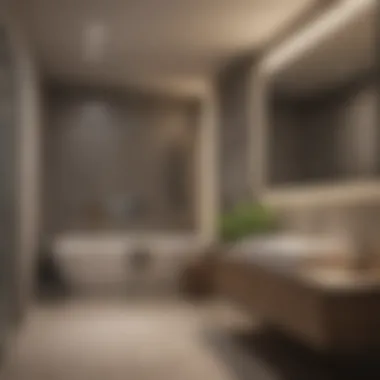
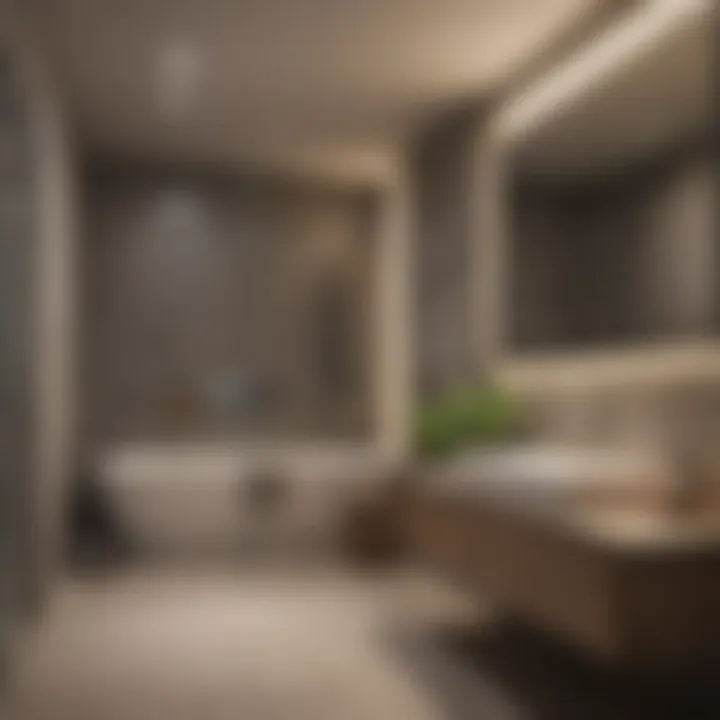
Tasks Performed in the Bathroom
Understanding the specific tasks performed in the bathroom guides the selection of appropriate lighting. Different activities require varying levels of illumination. For example, makeup application and shaving are precision tasks that need bright, shadow-free light. In contrast, a calming bath may benefit from softer, warmer lighting.
Some common tasks in the bathroom include:
- Makeup application: This requires bright, even lighting to avoid harsh shadows that can affect the final look.
- Shaving: Proper lighting is critical to ensure accuracy and safety while shaving.
- Nighttime routines: Gentle lighting is useful when performing nighttime tasks, preventing disruption to natural sleep patterns.
- General cleaning: Ample light helps in spotting areas that need attention, ensuring a clean and tidy space.
Ultimately, understanding the tasks performed will allow homeowners to master the art of bathroom lighting, ensuring each activity is supported by the right amount of light.
Factors Influencing Wattage Selection
Understanding the factors influencing wattage selection is crucial for achieving effective bathroom lighting. The right wattage not only impacts brightness but also influences the overall atmosphere. Key elements include the size and layout of the room, the types of light fixtures in use, and the color temperature of the bulbs. Each of these factors impacts how light is distributed and perceived within the space. Therefore, careful consideration is needed to balance function and ambiance.
Room Size and Layout
The size and layout of a bathroom significantly dictate the wattage required for effective lighting. Smaller bathrooms often do not require as much wattage because they can become overly bright and uncomfortable with high light levels. Conversely, larger bathrooms may need higher wattage to ensure adequate illumination across the entire space. Moreover, the layout, including features such as mirrors, windows, and the location of fixtures, plays an essential role in lighting distribution. A well-thought-out lighting plan considers not just the watts but also how that light will interact with various surfaces to enhance visibility and ambiance.
Light Fixture Type
The type of light fixture can also influence wattage selection. Different fixtures have unique characteristics that allow for varied light output, efficiency, and usability.
Incandescent Bulbs
Incandescent bulbs are traditional options for bathroom lighting. One key characteristic of incandescent bulbs is their warm light quality, which can create a welcoming atmosphere. They are often easy to install and replace. These bulbs typically use more energy compared to newer technologies and have a shorter lifespan. However, their warm glow can enhance the ambiance of the bathroom, making them a popular choice despite lower energy efficiency.
LED Bulbs
LED bulbs, or Light Emitting Diodes, are a more energy-efficient alternative. They offer remarkable luminosity with substantially lower wattage. One standout characteristic of LED bulbs is their longevity; they can last up to 25 times longer than incandescent bulbs. This durability makes them a strong option for homeowners looking to reduce maintenance. While the initial cost may be higher, the long-term savings in energy consumption and replacement make them a popular choice. It's worth noting that LED technology now offers a wide range of color temperatures to suit various preferences.
CFL Bulbs
Compact Fluorescent Lamps, or CFL bulbs, provide another energy-efficient lighting option. One notable aspect of CFLs is their ability to mimic the warm glow of incandescent bulbs while consuming less wattage. They are a midway option in terms of cost between incandescent and LED options. However, like LEDs, CFLs take a moment to warm up, which may be a disadvantage in certain situations. Overall, they present an efficient choice for those seeking to reduce energy use without sacrificing quality of light.
Color Temperature Considerations
Color temperature is an important concept to consider when selecting bathroom lighting. Measured in Kelvins (K), it dictates the warmth or coolness of the light emitted by bulbs. Warmer temperatures (2700K to 3000K) create a cozy environment, while cooler temperatures (3500K to 5000K) produce a brighter, more energizing effect. The choice of color temperature should align with the bathroom's purpose and desired atmosphere. For example, warmer hues can enhance a relaxing spa-like feel, whereas cooler tones can help when precise tasks, like shaving, are being performed. Therefore, selecting the right color temperature in conjunction with wattage can enhance both functionality and ambiance.
Recommended Wattage Guidelines
Choosing the right wattage for bathroom lighting is crucial for establishing both functionality and comfort. The wattage impacts how well the bathroom serves its purpose. Insufficient lighting can lead to a lack of visibility, while overly bright lights may cause discomfort. Here, we will outline general guidelines as well as specific needs based on common tasks performed in the bathroom. Understanding these recommendations can help in creating an ideal atmosphere.
General Recommendations
In general, the recommended wattage for bathroom lighting tends to vary depending on the size of the space. A guideline often cited is about 2 watts per square foot of the bathroom's total area. This provides enough brightness without causing glare or harsh lighting.
For smaller bathrooms, like a powder room, you may need about 50 to 100 watts in total. For larger bathrooms, a total between 100 to 200 watts may be necessary. These numbers can be adjusted slightly based on the number of fixtures used and the type of light bulbs chosen.
LED bulbs offer higher output with lower wattage. Hence, if you are using LED lighting, 50 to 75 watts may suffice for smaller spaces, while larger areas might need 100 to 150 watts. The point is to ensure the space is well-lit without feeling stark or clinical.
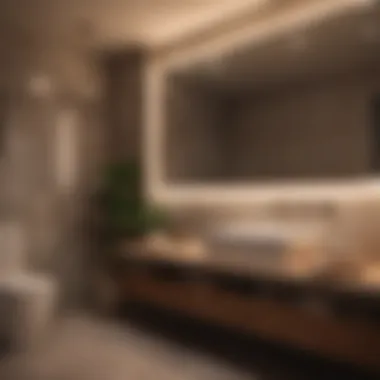
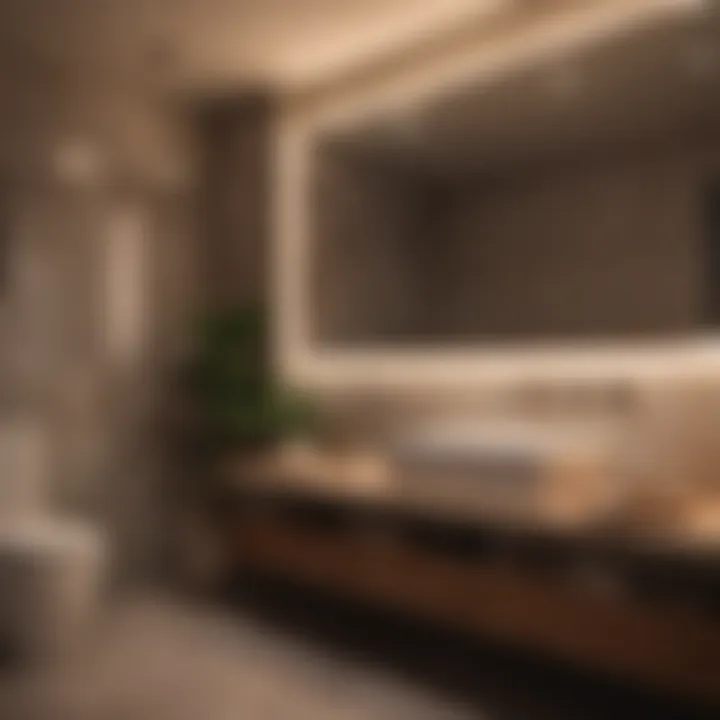
Task-Specific Lighting Needs
This section addresses specific tasks commonly performed in the bathroom. Each task has unique lighting requirements that can greatly enhance the experience.
Makeup Application
Makeup application necessitates bright, even lighting. Typically, a combination of overhead and side lighting works well. A recommended total of 100 to 150 watts can be suggested here that includes both ceiling fixtures and wall sconces. Individual preferences vary, but the focus is on avoiding shadows on the face, as this can alter how cosmetics are applied.
A unique feature of this area is the use of light sources that mimic natural daylight. This allows for a more accurate representation of how makeup will appear in various environments, making it a beneficial choice in this context.
Shaving and Grooming
Shaving requires careful attention and good visibility. It is recommended to have around 80 to 120 watts for this task, again utilizing a mix of lighting types. Focusing on lighting that minimizes shadows near mirrors is crucial.
A key characteristic in this area is the placement of lights to avoid glare. If possible, install fixtures that provide a clear view without reflecting harshly off mirrors. This would ensure that users can see clearly, thus enhancing the grooming experience.
Overall, it is vital that lighting for both makeup application and shaving is adjustable, allowing for the appropriate intensity based on time of day and personal preference.
Balancing Ambience and Functionality
In any bathroom, achieving a balance between ambience and functionality is paramount. This concept emphasizes the need for a well-lit space that is not only efficient for daily tasks but also creates a soothing atmosphere. Proper wattage selection plays a critical role in this balance. It is essential to ensure that lighting is both bright enough for practical use and soft enough to foster relaxation.
The right lighting scheme can enhance the overall experience from morning routines to leisurely baths. An overly bright space may contribute to a harsh environment, while inadequate illumination can hinder essential tasks such as shaving or applying makeup. Understanding how to blend these aspects can elevate both the aesthetic and the utility of the bathroom.
Layering Lighting Sources
Layering lighting is crucial for achieving a dynamic environment in the bathroom. This approach entails using various types of lighting—task, ambient, and accent—to create a holistic and flexible lighting strategy.
- Task Lighting: This is the most direct lighting, aimed at specific activities. For example, vanity lights positioned above or beside mirrors provide focused illumination for grooming tasks.
- Ambient Lighting: This serves as the primary source of light that fills the entire room. Ceiling fixtures or recessed lighting can create an inviting atmosphere, enhancing the room's overall aesthetic.
- Accent Lighting: This can highlight certain features, like artwork or tiles, adding depth to the design while providing visual interest.
By layering these different types of lighting, homeowners can adjust the ambience for different occasions, whether it’s a quick morning routine or a relaxing evening bath. Different wattages in these layers can contribute to the desired effect, ensuring that each type of lighting performs its intended function.
Adjustable Lighting Options
Adjustable lighting options bring flexibility to bathroom lighting schemes. Dimmers, for example, can transform the space by allowing users to modify the brightness based on the time of day or activity. Installing dimmable switches on task lighting can help create a more comfortable setting during evening hours, reducing the harshness of bright lights.
In addition to dimmers, multi-functional fixtures are increasingly popular. For instance, having a light bar above the mirror that can change from bright white to softer yellow enhances adaptability depending on the task. This choice accommodates various lighting needs throughout the day by altering both the brightness and color temperature, ultimately supporting better visibility for activities while promoting relaxation after a busy day.
Common Bathroom Lighting Mistakes
Selecting the right wattage for bathroom lighting can be a daunting task. Homeowners must consider various aspects to achieve a well-lit environment that serves both functional and aesthetic purposes. In this section, we will explore common mistakes that people often make regarding bathroom lighting. Avoiding these pitfalls is crucial to ensuring a pleasant experience in an essential space like the bathroom.
Overly Harsh Lighting
One of the most frequent errors in bathroom lighting is the use of overly harsh or bright lights. Excessive brightness can create an uninviting atmosphere and may even cause discomfort. It can lead to harsh shadows, making tasks such as shaving or applying makeup more challenging.
Several factors contribute to this mistake. First, many individuals tend to prioritize brightness levels without considering the appropriate ambient lighting. Too much lighting can take the warmth out of the room, making it feel cold and sterile. It is essential to strike a balance between adequate task lighting and ambient light.


When choosing bulbs, consider the lumens instead of just wattage. Lumens indicate the amount of light emitted, while wattage indicates energy use. Select bulbs that provide sufficient lumens without overwhelming the space. Additionally, employing dimmers can give the flexibility to adjust the brightness according to the time of day or mood.
Key Takeaway: Avoid excessively bright lighting to maintain a warm and welcoming bathroom environment. Aim for a balanced combination of ambient and task lighting to enhance usability without overwhelming the senses.
Insufficient Lighting Fixtures
Another common mistake homeowners make is underestimating the number of lighting fixtures needed in the bathroom. Insufficient fixtures can lead to poorly lit areas and create shadows that can complicate detailed tasks. Whether you are getting ready for work or unwinding after a long day, proper lighting is crucial.
The layout and size of the bathroom significantly influence fixture requirements. A small bathroom may only need one or two fixtures, while larger spaces may require more units to distribute light evenly. Consider integrating sconces or additional ceiling lights in key areas to enhance illumination.
Furthermore, the placement of fixtures also matters. Many people overlook the importance of light placement relative to mirrors. Positioning fixtures too close or too far from mirrors can result in inadequate lighting for grooming tasks. Ensure that the fixtures provide enough light where it is most needed.
By thoughtfully planning the number and placement of your bathroom lighting fixtures, you can avoid dark corners and create a more functional space.
In summary, accounting for common lighting mistakes can significantly elevate the comfort and utility of your bathroom. Pay attention to the brightness level and ensure you have sufficient and effectively placed lighting fixtures.
Energy Efficiency and Sustainability
In contemporary design, energy efficiency and sustainability play critical roles, particularly in bathroom lighting. Homeowners increasingly seek environmentally friendly solutions that not only reduce energy consumption but also enhance the aesthetic appeal of their spaces. Making informed choices regarding wattage and fixture types can significantly decrease energy usage while maintaining effective lighting.
Rethinking lighting choices often leads to better sustainability outcomes. The growing concern over climate change and rising energy costs urges homeowners to adopt strategies that minimize their ecological footprint. This article emphasizes the importance of not just choosing the correct wattage, but also understanding the implications of those choices on both the environment and household energy bills.
Benefits of LED Lighting
LED lighting is at the forefront of energy-efficient solutions for residential spaces. They consume significantly less energy than traditional incandescent and fluorescent bulbs, often using up to 75% less. This not only translates to reduced electricity bills but also contributes to lower greenhouse gas emissions.
Moreover, LED bulbs have an impressive lifespan, often reaching up to 25,000 hours. This longevity reduces the need for frequent replacements, which further helps decrease waste—both economically and environmentally. When implementing LED lighting in bathrooms, it is crucial to consider:
- Brightness Levels: LEDs provide versatile brightness options, allowing homeowners to select the right wattage for specific tasks.
- Color Temperature: They are available in various color temperatures, providing both warm and cool lighting choices that can enhance any design scheme.
- Heat Emission: Unlike traditional bulbs, LEDs emit very little heat, contributing to more comfortable bathroom environments.
"Switching to LED lighting is one of the simplest ways to improve energy efficiency at home, offering both environmental benefits and cost savings."
Reducing Energy Consumption
Reducing energy consumption in bathrooms can be achieved through several strategies, beyond simply choosing the right wattage. Here are some effective approaches to optimize energy use:
- Smart Lighting Systems: Integrating home automation can allow for smarter control over bathroom lighting, using motion sensors and timers to ensure lights are only on when needed.
- Dimming Solutions: Implementing dimmers provides flexibility in light intensity, allowing for lower wattage use during non-essential tasks while still providing clarity when needed.
- Natural Light Utilization: Maximizing the use of natural light during the day can dramatically cut energy usage. Consider strategically placing mirrors to reflect light and create a brighter space without added wattage.
- Regular Maintenance: Keeping fixtures clean ensures they emit maximum light output, which can reduce the wattage requirement to achieve the desired brightness.
By understanding the interrelation of these techniques and pairing them with appropriate wattage decisions, homeowners can create a bathroom environment that is both stylish and sustainability-focused.
End and Final Recommendations
In this article, we have explored the essential aspects of bathroom lighting, focusing specifically on identifying the optimal wattage for effective illumination. Understanding the nuances between wattage, fixture types, and the specific tasks performed in the bathroom is crucial for creating a functional and inviting space. Bathroom lighting serves both utilitarian and aesthetic purposes. Thus, it is important to balance these elements effectively.
Selecting appropriate wattage not only impacts visibility during personal grooming or applying makeup but also contributes to the overall atmosphere of the room. The key is to ensure that lighting meets the distinct needs of this often-misunderstood space. By understanding your specific needs, you can enhance both the functionality and the ambiance of your bathroom environment.
Another critical aspect discussed is the importance of energy efficiency. Choosing energy-efficient solutions, like LED bulbs, helps to reduce your carbon footprint while also saving on electrical bills. It is advisable to consider LED as a preferred option due to their longevity and lower energy consumption compared to traditional incandescent or CFL options. In summary, the right choice of wattage effectively ties together the considerations surrounding energy use, aesthetics, and user needs.
Summary of Key Points
- Understand Your Needs: Assess the various functions of your bathroom.
- Consider Fixture Types: Different bulbs offer varying levels of efficiency and warmth.
- Room Size Matters: Tailor wattage choices to the dimensions of your space for optimal results.
- Evaluate Energy Efficiency: Opt for LED options when possible.
- Create Balance: Ensure a mix of ambient and task lighting for versatility.
Next Steps for Implementation
- Evaluate Your Current Setup: Review your existing lighting fixtures and noted areas needing improvement.
- Plan for Different Zones: Differentiate lighting needs for various areas, such as shower spaces versus vanity areas.
- Select Appropriate Fixtures: Research and choose light fixtures based on wattage recommendations and design preferences.
- Install Energy-Efficient Bulbs: Replace existing bulbs with the recommended wattage of LEDs or other suitable options.
- Test the Arrangement: Once installed, assess the lighting and make adjustments as necessary to strike a pleasing balance.







